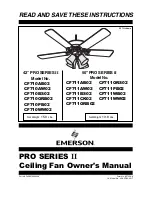
1.
Restore electrical power to the outlet box by turning
the electricity on at the main fuse box.
2.
Check the operation of the light by gently pulling on
the light switch pull chain.
3.
Check the operation of the fan by gently pulling on
the speed control switch pull chain. The operation
sequence is as follows:
1st pull - High
2nd pull - Medium
4.
Your fan is shipped from the factory with the
reversing switch positioned to circulate air
downward. If airflow is desired in opposite
direction, turn the fan off and wait for the blades to
stop turning, then slide the reversing switch to the
opposite position, and turn the fan on again. The
fan blades will turn in the opposite direction and
reverse the airflow.
9
Using Your Ceiling Fan
SPEED CONTROL
PULL CHAIN SWITCH
REVERSING
SWITCH
LIGHT PULL
CHAIN SWITCH
Trouble Shooting
TROUBLE
PROBABLE CAUSE
SUGGESTED REMEDY
1. Fan will not start.
1. Fuse or circuit breaker blown.
1. Check main and branch circuit fuses or circuit breakers.
2. Loose power line connections to the fan, or loose
2. Check line wire connections to fan and switch wire
switch wire connections in the switch housing.
connections in the switch housing.
WARNING:
Make sure main power is turned off.
3. Reversing switch in neutral position.
3. Make sure reversing switch position is all the way to one
side.
2. Fan sounds noisy.
1. Blades not attached to fan.
1. Attach blades to fan before operating.
2. Screws securing fan blade flanges to motor hub
2. Check to make sure the screws which attach the fan
are loose.
flanges to the motor hub are tight.
3. Wire connectors inside switch housing rattling.
3. Check to make sure wire connectors in switch housing
are not rattling against each other or against the interior
wall of the switch housing.
WARNING:
Make sure main power is turned off.
4. Motor noise caused by solid-state variable
4. Some fan motors are sensitive to signals from Solid-
speed control.
State variable speed controls. If Solid-State Control
is used and motor noise results choose an alternative
control method.
5. Screws holding blades to flanges are loose.
5. Tighten screws securely.
3. Fan wobbles
1. Setscrews in motor coupling are loose.
1. Tighten both setscrews securely in the motor coupling.
excessively.
2. Setscrew in hanger ball/downrod assembly is
2. Tighten the setscrew in the hanger ball/downrod
loose.
assembly.
3. Screws securing fan blade flanges to motor are
3. Check to be sure screws which attach the fan blade
loose.
flanges to the motor are tight.
4. Fan blade flanges not seated properly.
4. Check to be sure the fan blade flanges seat firmly and
uniformly to the surface of the motor.
5. Hanger bracket and/or ceiling outlet box is not
5. Tighten the hanger bracket screws to the outlet box,
securely fastened.
and/or secure outlet box.
6. Fan blades out of balance.
6. Interchanging an adjacent (side-by-side) blade pair can
redistribute the weight and result in smoother operation.
WARNING:
For your own safety, turn off power at fuse box or circuit breaker before trouble
shooting your fan.
!
!
!
3rd pull - Low
4th pull - OFF
U.L. Model No.: 42-ANT/52-ANT






























